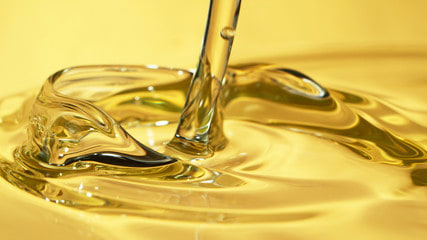
Base Oil Groups & Specifications
Base oil types are generally classified into two categories:
- mineral
- synthetic
Mineral base oil is obtained through the refining process of crude oil. During this process, a small portion of crude oil, approximately 1 to 2% of a barrel, is refined to produce base oil, while the remaining portion is used for various hydrocarbon products such as gasoline, diesel, kerosene, coke, and bitumen.
The refining process involves heating the crude oil, causing the separation of light and heavy hydrocarbons. The lighter hydrocarbons are processed further to produce fuels like petrol, while the heavier ones are refined to yield bitumen and base oil.
On the other hand, synthetic base oil is manufactured through chemical synthesis. This type of base oil is classified into two categories: paraffinic and naphthenic, based on the chemical structure of the molecules present. Synthetic base oil contains hydrocarbons with carbon atom counts ranging from 18 to 40.
Naphthenic base oil types exhibit superior solubility and performance at low temperatures compared to other base oil types. Typically, lubricating oil contains a mixture of base oil and specific additives, constituting around 1% to 20% of the total volume.
To obtain a pure sample of base oil, a hydrogenation process is employed, which involves the removal of sulfur and aromatics by subjecting the oil to high-pressure hydrogenation.
Chemical additives are incorporated into base oil to enhance its quality for specific products, particularly in terms of friction. For example, certain motor oils may contain more than 20 different additives.
Base oil is categorized into five main groups based on viscosity, saturate proportion, sulfur content, and other factors.
Group 1:
The American Petroleum Institute (API) designates this group as base stocks with characteristics including less than 90% saturates, sulfur content greater than 0.03%, and a viscosity index between 80 and 120.
Group 2:
API classifies this group as base stocks with characteristics including equal to or greater than 90% saturates, sulfur content equal to or less than 0.03%, and a viscosity index between 80 and 120.
Group 3:
API refers to this group as base stocks with characteristics including equal to or greater than 90% saturates, sulfur content equal to or less than 0.03%, and a viscosity index equal to or greater than 120. Group 3 oils are also known as synthetic technology oils or hydrocracked synthetic oils.
Group 4:
Group 4 oils have a viscosity index ranging from 125 to 200. These oils are synthetic and primarily composed of Poly Alpha Olefins (PAO). PAO oils offer enhanced stability across various temperatures, making them particularly suitable for both freezing environments like Northern Europe and hot climates such as the Middle East.
Group 5:
Group 5 is dedicated to naphthenic oils and esters.
Base oil is available in various grades, including SN 150, SN 300, SN 500, and SN 650. The “SN” in these grades stands for Solvent Neutral base oil, and the numbers represent the SUS Viscosity at 40°C. SN 150, SN 300, and SN 500 are light in color, while SN 650 has a darker color. Generally, the higher the viscosity index, the darker the color tends to be.
Qatran Pars provides the following specifications for different types of Base Oil:
Base Oil SN 150:
|
|
||
|
Test Items |
Test Method |
Test Results |
|
Appearance |
Visual |
Bright & Clear |
|
Color |
ASTM D 1500 |
2.0 – 2.2 |
|
Density @ 30 C |
ASTM D 1298 |
0.870 |
|
Kinematic Viscosity @ 40 C |
ASTM D 445 |
30.0 – 31.54 |
|
Kinematic Viscosity @ 100 C |
ASTM D 445 |
5.0 – 5.5 |
|
Viscosity Index |
ASTM D 2270 |
90 – 92 |
|
Flash Point, C |
ASTM D 92 |
200 – 210 |
|
Pour Point, C |
ASTM D 97 |
-3 |
Base Oil SN 300:
|
Specifications of Qatran pars Base Oil SN 300 |
||
|
Test Items |
Test Method |
Test Results |
|
Appearance |
Visual |
Bright & Clear |
|
Color |
ASTM D 1500 |
2.0 – 2.2 |
|
Density @ 30 C |
ASTM D 1298 |
0.870 – 0.880 |
|
Kinematic Viscosity @ 40 C |
ASTM D 445 |
45.0 – 65.0 |
|
Kinematic Viscosity @ 100 C |
ASTM D 445 |
6.5 – 8.0 |
|
Viscosity Index |
ASTM D 2270 |
89 – 92 |
|
Flash Point, C |
ASTM D 92 |
210 – 220 |
|
Pour Point, C |
ASTM D 97 |
-3 |
Base oil SN 300 is a light-grade oil with a long shelf life and high thermal stability.
Base Oil SN 500:
Base oil SN 500 is the most sought-after grade among others. It is defined as a light-grade base oil and finds extensive use in lubricant production.
Usage: Engine oils, gear oils, greases, hydraulic oils, transformer oils.
|
Specifications of Qatran Pars Base Oil SN 500 |
||
|
Test Items |
Test Method |
Test Results |
|
Appearance |
Visual |
Bright & Clear |
|
Color |
ASTM D 1500 |
2.0 – 2.2 |
|
Density @ 30 C |
ASTM D 1298 |
0.885 – 0.890 |
|
Kinematic Viscosity @ 40 C |
ASTM D 445 |
97.5 – 102.0 |
|
Kinematic Viscosity @ 100 C |
ASTM D 445 |
10.5 – 11.5 |
|
Viscosity Index |
ASTM D 2270 |
89.0 – 92.0 |
|
Flash Point, C |
ASTM D 92 |
225 – 235 |
|
Pour Point, C |
ASTM D 97 |
-3 |
